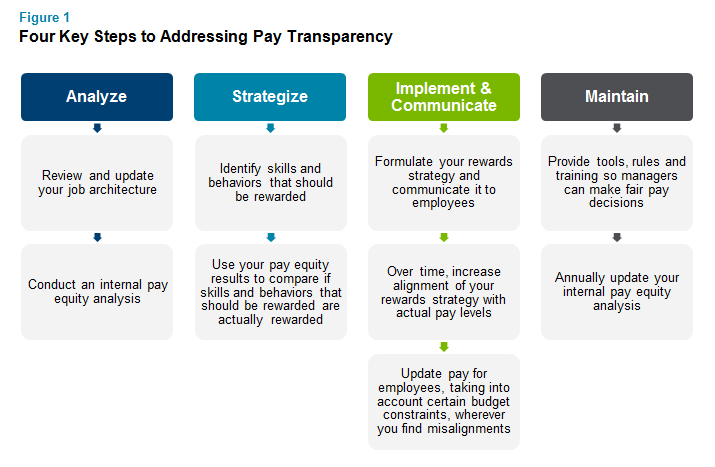Technological advances and new pay equity laws give employees access to data they never had before. Companies need to be ready to address inequities and tell their story in new ways.

For more than two decades, employees have had access to online sites and tools designed to help them negotiate a better paycheck. Yet, while access to crowdsourced compensation data on the internet is nothing new, how employees use these online resources, discuss pay with others and feel empowered to challenge corporate pay decisions is changing in profound ways. The era of pay transparency is here, and HR and compensation professionals no longer hold all the cards.
Why is this change happening now? There are several reasons. First, as technology continues to advance and people become more open to sharing information about themselves online, the number of websites offering crowdsourced compensation data has proliferated dramatically in the past three years. While the accuracy of many of these online resources remains debatable, more and more people have access to compensation information and are willing to use it. Second, the type of information available online is expanding as well, going beyond basic benchmarks to include data on pay practices, benefits, perks and culture at specific companies. Third, younger generations of employees are increasingly open to sharing their pay details with colleagues. Discussing pay at work is no longer a taboo subject. Finally, the topic of pay fairness is now a mainstream media and political issue in the United States (US) and several other countries. From Hollywood to major technology players, pay equity is in the news almost daily. Additionally, a number of new pay equity laws are coming into force that will compel companies to change how they negotiate pay with new recruits, set compensation levels and discuss pay fairness with employees.
On the legislative side, the California Fair Pay Act is a particularly instructive harbinger of things to come. While numerous other states and cities in the US, including Oregon, Massachusetts and New York City, have signed into law pay equity regulations that limit the ability of employers to keep pay levels a secret, California takes things a step further. Employers in the state are now required to “provide the pay scale for a position to an applicant applying for employment […] upon reasonable request.”
While companies can design policies to limit the size of the applicant pool that can “reasonably” request and receive pay scale information for a job, ultimately, this law mandates the release of pay information to some number of external and/or internal job applicants. Once you release information of this nature to applicants, it will become harder to withhold it from other colleagues. Likewise, once you release pay information to your California-based employees, it will be very hard to withhold the same information from their colleagues in other states. In other words, inevitably people will talk when presented with data that was previously thought to be fairly secretive and protected.
To illustrate how the era of pay transparency can impact an organization, we like to share the example of a recent client engagement:
Case Study: How Pay Transparency Can Create Disruption
After conducting an internal pay equity analysis, one of our client companies decided to adjust pay for select employees found to be underpaid relative to peers in similar positions. After the adjustments were made, employees started talking, shared data points, and ultimately, several people complained to HR. Notably, employees were upset that employee tenure did not appear to correspond to higher pay adjustments. There was a clear misalignment between what employees perceived to be fair and what they now knew was the pay reality.
We were brought in to find out what exactly was going on and how best to proceed. Once we began to peel back the layers of the company’s analysis, it was easy to see what happened. To keep up with pay levels in the external market, the client had increased starting pay for nearly every position. At the same time, to manage labor costs, the company reduced merit increases across the board. The result was that employee tenure had no positive impact on base pay.
Over the years, employees heard from management that they value and pay for longevity, which turned out to be contrary to the facts. Once those facts became apparent, the disconnect could no longer be ignored. The solution wasn’t an easy fix. We worked with the client to provide pay adjustments to high-performing and valued long-term employees and provided tools to compute equitable starting pay to prevent new-hire pay from surpassing tenured pay. However, the damage was already done and it took a lot of one-on-one conversations with managers and employees to restore trust in the compensation system.
As the case study above demonstrates, even when companies are very well-intentioned, once employees start comparing pay with one another, they will create their own definitions of fairness and strategic value. From there, if employees believe there are serious disconnects between pay and fairness, it’s easy to see the potential for serious side effects like poor engagement, lower productivity and higher turnover.
The likelihood of side effects of this nature means companies can’t treat pay equity adjustments as a simple matter of compliance. They must consider the full gamut of long-term ripple effects once they publicly declare to employees that they take fairness seriously. Pay transparency will force employers to proactively identify and manage a shared understanding of fairness that transcends all groups and individuals— not just pay equity by gender and race but pay equity for everyone.
How Can Companies Respond?
Most mid- to large-sized employers already have processes in place to establish and monitor pay fairness externally and internally (fair pay relative to employees working for other organizations and those working for the same organization), and strategic alignment between what the company intends to reward for and actual pay outcomes. The question is whether those existing processes are robust enough to withstand a new level of scrutiny. The difference is that employees can now actually fact-check whether the company’s pay-for performance philosophy is real. In other words, do you have the data and analytics to back up the story you’re trying to tell? Figure 1 below outlines the four key steps companies need to take to get their house in order. And from there, we explore each step in greater detail.

Step 1: Review your job architecture and job mapping system, and examine internal pay equity
If you market price all of your jobs it might be advisable to update and document your market benchmarks now, even if you did so last year. In parallel, it is also critical to run a regression-based internal pay equity analysis. You should run this analysis with a broader focus than just probing for pay gaps by gender and/or ethnicity. In the age of pay transparency it will become equally important to understand the factors that drive base bay and total compensation. Do you actually pay for performance as your compensation philosophy asserts? Did you back up your claim that you value tenure at the company? You want to check whether the story you have been telling your employees actually turns out to be true when they start comparing their pay levels. And if you haven’t told that story yet, now is probably the right time to start doing so before your workforce tells that story for you.
Step 2: Compare the findings of your internal pay equity analysis with your strategic business plan
If you decided to take action following an internal pay equity analysis, don’t stop at point-in-time pay adjustments. You’ll be selling the work you’ve just done short. Look for longer-term changes that will drive strategic value for the business. For example, if you learn that international assignments do not result in lasting pay advantages for employees, but you know your business benefits greatly from such assignments, then put policies in place that reward employees who spend time away from headquarters. Starting at the highest job levels and moving on down, seek out strategically-aligned behaviors and tasks that should be rewarded by the business, and then ask how you can change policies and compensation programs to migrate from the status quo to where you want to be in the future.
Step 3: Implement changes and develop a communications strategy
Once you’ve uncovered the facts and developed a strategy to respond to your internal pay equity analysis, you’ll need to communicate your plan to employees. This includes messaging your rewards strategy around the employee value proposition. This is not about reporting out a pay equation; instead, list the factors that drive pay at a high level along with an explanation of their business relevance. Simply saying, “We pay for performance” will not suffice. As you are telling your story it might be necessary to grant supplemental merit increases and make sure that pay reality meets up with pay strategy for everyone. Depending on your legal exposure and your budget availability not all pay updates have to occur at once. Such pay realignment is a long-term effort.
Step 4: Perform on-going maintenance
Your managers will require data and guidance to make pay decisions that go beyond annual merit matrices. For new hires, you will need to know market pay rates as well as internally equitable pay rates given the job, location and employees’ experience. The same is true for promotions and other out-of-cycle pay updates. The good news: the very technology that drives pay transparency pressures can also provide the data and tools to give managers the right information. For both internal and external equity assessments, there are now processes and tools available that allow you to estimate pay levels that take into account numerous characteristics of your organization, location, job requirements and even employees (e.g., experience, performance and tenure). Relatively basic augmentations to these tools can then add strategic alignment components to drive business-essential employee behaviors that currently are not rewarded. As part of on-going maintenance, we recommend updating your pay equity analysis annually. This is best done two to three months before your merit cycle to ensure necessary equity adjustments can be rolled into employee raises. Over time, annual adjustments will become smaller as other pay processes address pay misalignments at the time when pay decisions are made.
Next Steps
Pay transparency is a real challenge for compensation professionals around the globe. With a lot of attention being given to legislation, it’s important to also remember that another driver of change has been technology and the freer flow of information. If you can harness this information to build pay processes that are both fair and well-aligned with your organizational strategy, everyone wins.
To learn more about our point of view on gender pay equity and our comprehensive approach for delivering lasting change for your people and organization, visit our Pay Equity Matters site. To speak with a member of our consulting group, please write to consulting@radford.com.
equal pay, pay equality, fair pay, pay equality , gender pay, gender fair pay, pay gap, pay equity
Related Articles